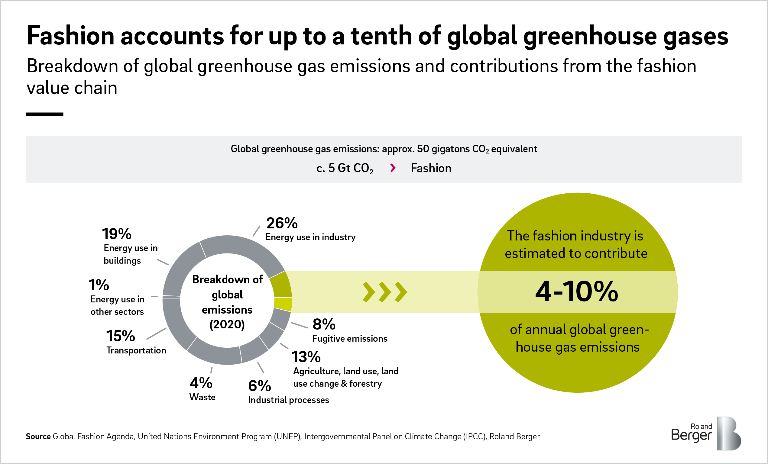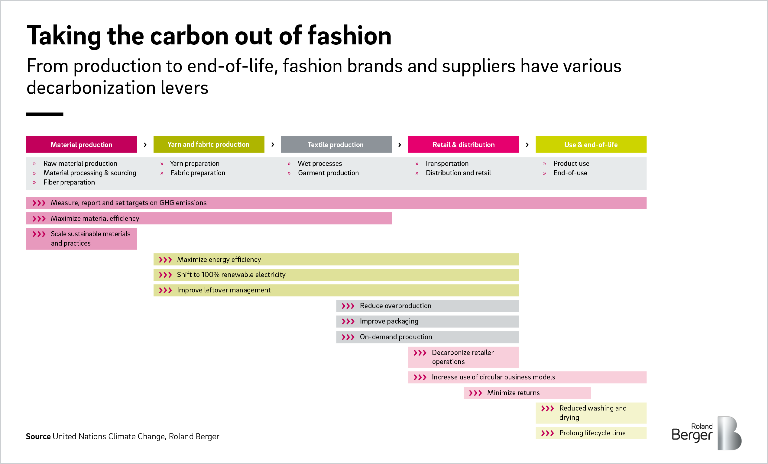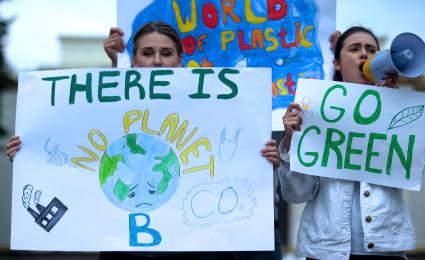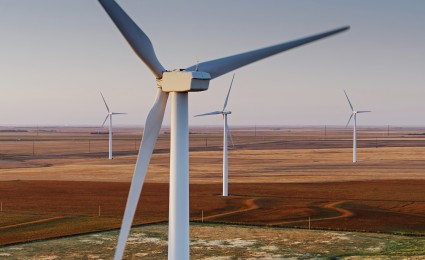Learn more about The Sustain Game, outlining five hypotheses on the future of the consumer goods and retail industry


High fashion, low emissions: Climate action in the textile and apparel industry
Sustainable Fashion - Challenges, solutions and a path to net zero
As one of the largest CO2 emitters in the world, reducing the environmental impact is a business imperative for the textile and apparel industry. Work has already started, but much more needs to be done to decarbonize and pave the way to sustainability. Here we look at the climate challenges facing the industry and offer climate action solutions for sustainable fashion.

"We outline a toolbox of proprietary decarbonization solutions to set up your business strategically, secure your bottom line and boost your top line."
Fashion – renowned as one of the most glamorous industries in the world. But what few fashionistas, trendsetters or ordinary consumers know is that it is also one of the industries with the biggest environmental impact. Producing, distributing, washing and disposing of clothes and footwear produces huge greenhouse gas (GHG) emissions across the supply chain, with some estimates suggesting they make up 10% of the world’s total. In addition, synthetic fibers and toxic chemicals used to make garments heavily pollute our rivers and oceans and increase the environmental impact of the fashion industry even more. The industry also sucks up precious resources, such as arable land and water.
It's clear the textile and apparel industry needs to make fast environmental changes. But the big question is, what actions do fashion companies need to take and how can they become sustainable? In this article, we shine a light on the climate challenges facing the textile and apparel industry and offer climate action solutions to them. Specifically, we outline a toolbox of proprietary decarbonization solutions to set up your business strategically, secure your bottom line and boost your top line. In addition, our benchmark tool assesses your position in the transformation journey towards becoming sustainable and helps to determine what to do next.
A challenging climate
As environmental awareness has grown over the past few years, especially when looking at the fast fashion industry, the fashion industry has been forced to address its pollution problem and tack towards more sustainable fashion. This has created multiple new markets and business models, moving away from fast fashion toward so-called slow fashion. Besides this, online clothes rental, vintage markets and made-to-order products have grown in popularity in the last years. We also see a large shift towards eco-friendly and fair-trade raw materials, such as organic natural fibers (including organic cotton). These changes have helped, but the industry needs to up its game to become more sustainable.
First steps into a sustainable future
A major step in the right direction is the UN-backed Fashion Industry Charter for Climate Action. It aims for the textile industry to achieve net zero emissions by 2050, and involves companies voluntarily committing to sustainability goals. These include monitoring and reporting their environmental impact and switching to renewable energy sources. So far, 125 companies and 41 supporting organizations, including major global fashion brands , have signed up.
One more concrete step is the just recently published EU Strategy for Sustainable and Circular Textiles from the European Commission, which includes specific sustainability regulations for all textile products placed on the EU market. While it is only a regulatory framework so far, it will become European law soon and all companies along the whole fashion lifecycle need to get ready to transform their whole business toward complying with this regulation.
Companies need to take action now
The latest climate data suggests that the pathway to limit global warming to 1.5C (the goal agreed at the UN COP21 climate summit in Paris in 2015) and achieve net zero by 2050 is becoming increasingly unrealistic. So what practical steps can fashion companies take to tackle global warming ?
First up, companies need to organize themselves so that all corporate functions are working towards the same goal, becoming sustainable as quickly as possible. This starts at the C-level, with, for example, CEOs setting out a clear climate action vision and CFOs identifying the necessary financing. But it’s also important that all employees buy in to the sustainability transformation. The article shows what every corporate function should be doing to become a sustainable fashion company.
Then comes decarbonization itself. Various climate action levers are available to fashion brands and suppliers. A key first step is to set up a system to define and measure GHG reduction targets. Next, fashion companies need to take action to reduce GHG emissions. They can do this by, for example, implementing programs aimed at boosting energy efficiency and the use of renewable electricity among suppliers and limiting overproduction. Not to forget the end-of-life use, for which clothing brands need to enable a circular fashion approach, with more materials to reuse and recycle.
Our climate action solutions
Theory isn’t always easy to put into practice, however. To help, we developed a ‘ready to wear’ solution – our decarbonization toolbox. It goes straight to the heart of the sustainability challenge, offering tools that help companies boost sustainability and thereby protect their long-term profitability. These include proprietary software that can lower emissions. The toolbox is outlined in detail in the publication, where we also give examples of the practical sustainability solutions we offer.
Next, our transformation maturity model enables companies to prioritize their climate action measures according to the stage they have reached in their sustainable transformation journey. No matter what your position, we offer a range of tailormade climate action tools to ensure you take the right next step, all outlined in the publication.
Finally, for those firms that are unsure of their position on the journey, we offer the ‘Sustain Game’ tool. It allows them to benchmark progress and see how it compares with competitors. Once a company knows its Sustain Game score, we can help them to improve its position and guide companies on their individual climate journey. Take a look at the publication for more details – it could help you set a new sustainability trend.
Register now to download the full publication to learn more about the future of the fashion industry and get regular insights into Retail & Consumer Goods topics.












